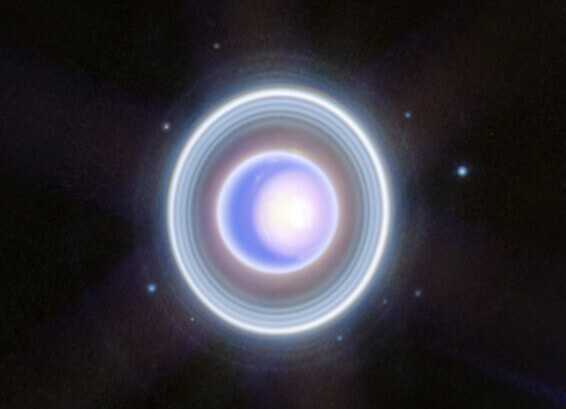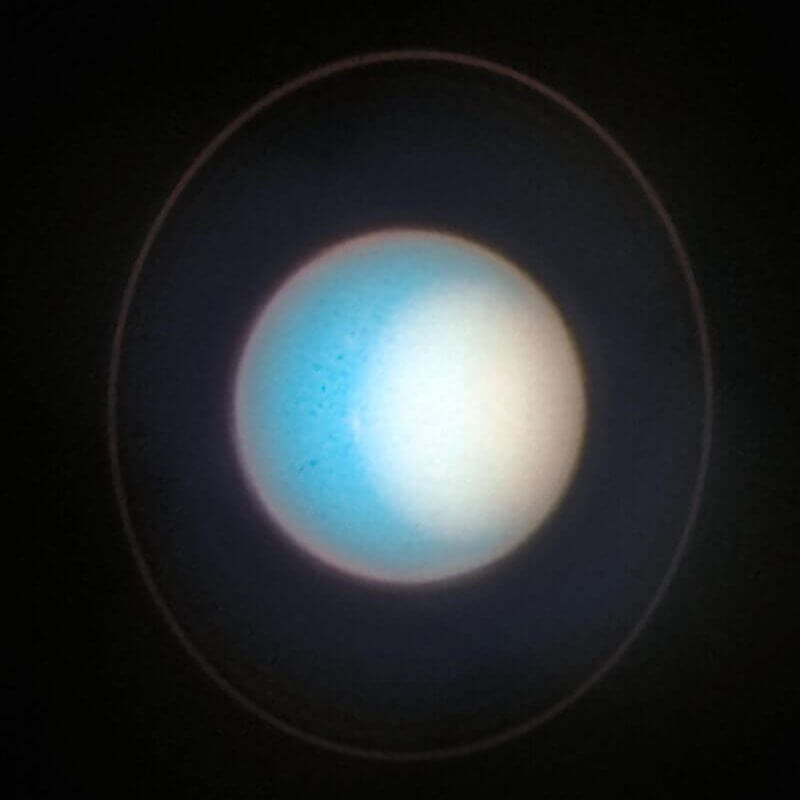(Source: Sorae Gateway to the Universe)
This image shows Uranus as seen with the Webb Space Telescope's Near Infrared Camera and Uranus as seen with the Hubble Space Telescope's Wide Field Camera 3 (WFC3). Although both are the same Uranus, they appear as different celestial objects depending on the wavelength and color used to image them.
source
- Image credits: NASA, ESA, CSA, Space Science Institute
- sorae – The latest images of Uranus observed using the James Webb Space Telescope have been released.
- sorae – Latest images of Uranus taken by the Hubble Space Telescope
![[▲ تم رصد أورانوس بواسطة كاميرا الأشعة تحت الحمراء القريبة لتلسكوب جيمس ويب الفضائي (NIRCam) في سبتمبر 2023 (Credit: NASA, ESA, CSA, STScI)]](https://sorae.info/wp-content/uploads/2023/12/Uranus-James-Webb-JWST-NASA-ESA-STScI-weic2332a.jpg)
This is the appearance of Uranus as observed on September 4, 2023. The image captures in great detail the body of Uranus, covered in white polar caps, surrounded by multiple faint, bright rings and numerous satellites.
This image was created based on data acquired by the James Webb Space Telescope's Near Infrared Camera (NIRCam). Because the Webb Space Telescope primarily observes infrared wavelengths that are invisible to the human eye, the colors of the published images are tinted according to the filters used during acquisition.
-Advertising link-
![[▲ تم تصوير أورانوس بواسطة الكاميرا واسعة النطاق 3 (WFC3) التابعة لتلسكوب هابل الفضائي في نوفمبر 2022 (الائتمان: NASA، ESA، STScI، A. Simon (NASA-GSFC)، MH Wong (UC Berkeley)، J. DePasquale (STScI)]](https://sorae.info/wp-content/uploads/2023/03/Uranus-2022Nov-Hubble-NASA-ESA-STScI-heic2303i.jpg)
![[▲ تم تصوير أورانوس بواسطة الكاميرا واسعة النطاق 3 (WFC3) التابعة لتلسكوب هابل الفضائي في نوفمبر 2022 (الائتمان: NASA، ESA، STScI، A. Simon (NASA-GSFC)، MH Wong (UC Berkeley)، J. DePasquale (STScI)]](https://sorae.info/wp-content/uploads/2023/03/Uranus-2022Nov-Hubble-NASA-ESA-STScI-heic2303i.jpg)
On the other hand, this image of Uranus was captured in visible light by the Hubble Space Telescope's Wide Field Camera 3 (WFC3) on November 10, 2022.
Uranus is a beautiful pale blue planet, with its right side covered in a white, hat-like cloud. According to the Space Telescope Science Institute (STScI), which operates the Hubble Space Telescope, this is a photochemically raised haze similar to smog over cities. Several small storms are also said to be visible around the edge of the haze.
In visible light, Uranus appears as a nice pale blue ball, but when seen in infrared wavelengths (colored according to wavelength), it appears to be a completely different celestial body.
Details about each image of Uranus are provided in the following articles.

New images of Uranus taken by the James Webb Space Telescope have been released.
2023.12.23
This is the appearance of Uranus as seen on September 4, 2023. The image captures in great detail the body of Uranus, covered in white polar caps, surrounded by multiple faint, bright rings and numerous satellites. …

Latest images of Uranus taken by the Hubble Space Telescope
2023.4.3
The NASA/ESA Hubble Space Telescope has been observing Jupiter, Saturn, Uranus and Neptune every year since 2014 as part of a program to capture changes in the atmospheres of the gas giant planets. …
Text Editing Department/Syrian
Read the original article

“Travel maven. Beer expert. Subtly charming alcohol fan. Internet junkie. Avid bacon scholar.”






![Uranus seen through the lens of Webb and Hubble[الصورة الفضائية اليوم]| Uranus seen through the lens of Webb and Hubble[الصورة الفضائية اليوم]|](https://sorae.info/wp-content/uploads/2024/03/webb-Hubble-uranus.jpg)
More Stories
The ranking of the best survival horror games selected by the IGN US editorial team has been released! Resident Evil RE:2 ranked first
Enjoy a hot cigarette while looking at whales and tropical fish under the sea ⁉︎ “Ploom Dive” is an amazing spatial video experience using Apple Vision Pro
Apple Watch now supports sleep apnea, watchOS 11 released – Impress Watch